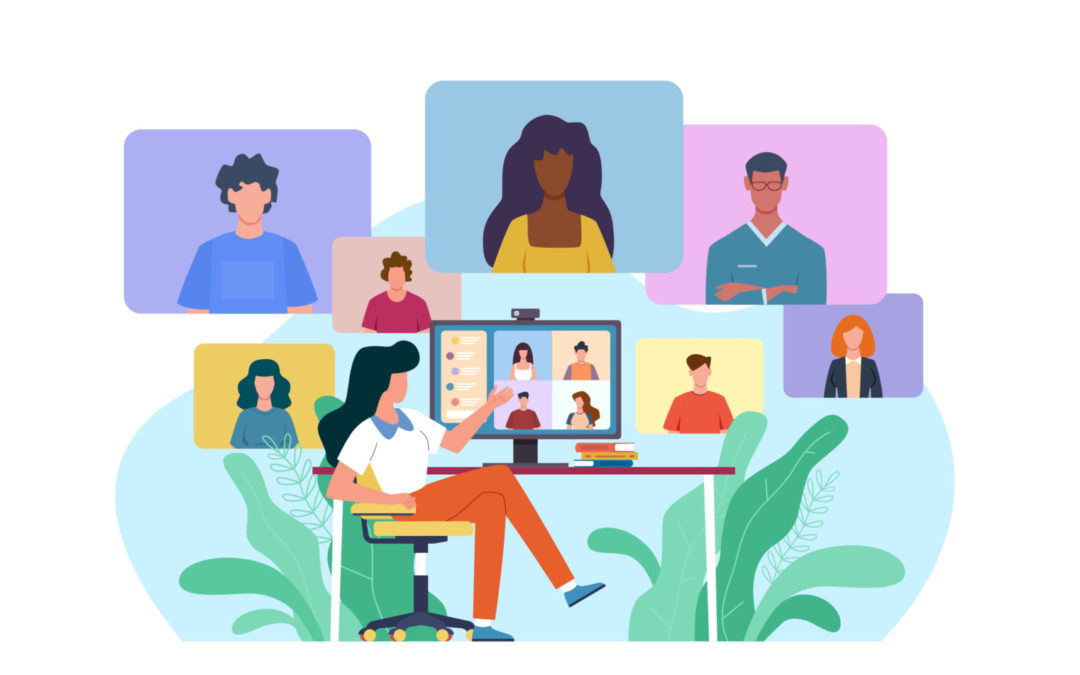
by American Business Women's Association | Oct 14, 2022 | Blog, Uncategorized
No single person, no matter how intelligent or experienced, can understand everything there is to know about a given job. Questions will come up, and when they do, the individual – whether a software developer, project manager, sales engineer – or any other title, needs to have a handle on the specific support that is needed, and how to ask for it.
With more people working remotely than ever before, this topic is emerging as a persistent issue. This is particularly true in fields like tech, in which teams must understand how to quickly resolve network and other systemic breakdowns and problems. Here are some ideas how to overcome lack of on-the-job support and seek help:
- Be sure to reach out to the right person. Many times, unhelpful or unsupportive people are acting out of lack of knowledge. Before you text, email, or phone, consider if you are contacting the correct individual. This person may have taken a different position in the company and is no longer current on the issues you need. If you require specific examples of what to do, reach out to someone good at providing practical advice – not someone who offers platitudes like, “You’re smart, you’ll figure it out.”
- Understand the support you need and ask for it Make it clear to colleagues and supervisors alike where you need help. Do you need support on a particular problem? Do you require assistance to better understand the project in its entirety? Perhaps you need to just grasp your specific role in it? Maybe you need greater flexibility to make a deadline. What is it, exactly, that you need? It’s not a good idea to assume that people will automatically know. Tell them.
- Set realistic expectations of others. Many times, people are weathering enough challenges of their own to help out. They may not have the time or resources to be as supportive as you’d like them to be. Is it possible you’re asking for too much? This is where realistic expectations come in. Be sure you’re asking for assistance, nothing more. If your requests are excessive, you will need to start giving back before you can expect any support in return.
- Lack of support often means lack of communication. It can prove difficult to obtain the help you need if there is a big gap in communication. An outgoing person may be happy to talk at length about your problem. But if you assimilate information better by watching a video that explains the issue, contact a colleague who will use a platform like this to help. You may not “get” what the other person is saying or the individual you’re asking might not understand your request because of a communication gap.
- Network, network, network. You can never know too many people! If a trusted colleague quits to take another job with another company and you’ve relied on him exclusively, what then? The plain fact is that people move away, retire, etc. As noted earlier, no single person knows everything. A network of trusted friends, coworkers, mentors, and the like can help in areas where help and support may be lacking. A change of perspective may be what you need instead of relying on the same person.
- Finally, be sure you are willing to accept criticism. We all like to give good advice but we are sometimes awful at accepting the advice of others as it forces us to admit our weaknesses. It’s normal for an individual to think they know more than they actually do. Remember, there is a reason you asked for assistance. Don’t take their suggestion personally. Consider if doing what the person advises will help you professionally. If it will, do it!
In conclusion, never assume a colleague, supervisor or manager understands what you are asking. Don’t rely on a single coworker for assistance and be sure to reach out to the person who can address your problem best. Good luck!
About the Author, Susanne Tedrick
Susanne Tedrick is an infrastructure specialist for Azure, Microsoft’s cloud computing platform. In her work, Susanne helps her clients address needs and challenges surrounding cloud adoption, cost optimization and migration. Susanne is the author of the critically acclaimed “Women of Color in Tech” and the upcoming “Innovating For Diversity”. For more information, please visit: www.SusanneTedrick.com.

by Rene Street | Aug 28, 2022 | Uncategorized
Four Strategies to Start Using Now
“I learned so much during orientation. It’s too bad I won’t use most of it for six months. I took some notes, but I’m sure I won’t remember half of what they told me to do.”
“I’m overwhelmed. I learned a new piece of equipment today. The person showing me what to do knew everything. The problem I had was the deep dives. He spent so much time on troubleshooting techniques. It was just too much for my first day.”
“I can follow the steps, but I have no idea why I’m doing what I’m doing. I sort of feel like a trained monkey. I hope nothing goes wrong because I will have no clue how to fix it if something does.
Despite our best efforts, it’s not as easy as it looks to get the training equation right. We train too early, we train too much, or we make a host of other errors. While some of us learn from our mistakes, many of us practice a cycle of rinse and repeat as we make the same blunders year after year. The good news is it doesn’t have to be this way. With some careful planning and follow through, you can avoid problems many people will encounter again and again.
Strategy One: Keep Training Relevant and Immediately Applicable
Countless onboarding programs attempt to teach everything a person would ever want to know or need to know about a job in the first few hours, days, or weeks. The information is important, but it has no immediate value. Subsequently, learners become overwhelmed in class, and then they don’t have opportunities to apply or reinforce what they’ve learned for months or even years.
Good training designers know the value of careful pacing, and they practice just-in-time training when they can. Ask yourself, what does my learner need to be successful in the first day, the first week, and the first month? Teach to those needs as much as possible, and save the more in-depth information for a more appropriate time. What do you need to prioritize?
Strategy Two: Connect to Why Again and Again
When people don’t know why they are doing something, they don’t understand the big picture. While they get the process at a surface level, their limited understanding potentially keeps them from following procedures later.
For example, if someone is learning how to use a print/copier/scanner/fax machine and part of the process is putting the guard up on the paper tray with jobs over 100 sheets, without explaining as to why that’s important to do, that learner might take it upon himself to skip that step back on the job. Only when papers are scattered all over the floor and have to be re-collated does the learning know the importance of raising the guard.
Great trainers make connections. They repeatedly explain why they’re doing what they’re doing, why procedures are written as they are, and so forth. Are you connecting the dots as well as you should, or could you do a better job?
Strategy Three: Use Multiple Channels to Cement Learning
I showed her how to do it, she did it, and now she’s trained. Maybe that’s true for the simple stuff, but for the complex processes and procedures, multi-channel encoding reigns supreme.
For example, show learners in real-time how to complete a process. Then do it again, at the same time providing a narration track while the learner takes notes. Next, have the learner read aloud the notes she’s taken. Finally, have the learner demonstrate the procedure.
The multi-channel approach allows learners to see, to hear, to write, to speak, and to do whatever process they are learning. Depending on the learner, some senses may be more powerful than others. And in rare cases where there is no preference, repetition wins the day. What can you do differently to engage more senses?
Strategy Four: Teach with Reference Tools
- It’s one thing to conquer a task during class or one-on-one job coaching, but it’s entirely another to reproduce those results on the job.
- People who have mastered the training function know to develop and teach reference tools in addition to processes themselves.
- Ask yourself what kinds of support you need to develop. Decide where you need to incorporate them in your training plans. Those who learn how to solve problems themselves are worth their weight in gold. In addition to strong productivity, these people are also usually happier and more motivated than those who don’t have the tools to stand on their own feet.
Four strategies and none hard: make training relevant, connecting to why, repeating information using different channels, and incorporating the tools learners should use to solve problems back on the job. If done deliberately and with routine, you will almost certainly get a good result.
About the Author
Kate Zabriskie is the president of Business Training Works, Inc., a Maryland-based talent development firm. She and her team provide onsite, virtual, and online soft-skills training courses and workshops to clients in the United States and internationally. For more information, visit www.businesstrainingworks.com.

by American Business Women's Association | Jun 27, 2022 | Blog
What’s your favorite underdog story? Why did you root for them? Whether it is a small company up against a big company or dynasty sports team against the Bad News Bears, you know the stories. You’ve probably seen countless times in every sports history, from the Pirates defeating the Yankees in 1960 to the 1980 USA Olympic Hockey team. Hollywood even makes movies about the loveable underdog. Legends are made because the odds are stacked against them. Have the odds ever been stacked against you? Perfect.
HERE ARE FIVE WAYS YOU CAN WIN AS THE UNDERDOG:
1) Tap Into the “Underdog Effect,” the Odds Against You Can Be an Asset.
Ever wonder why people root for the underdog? More importantly, how can you get people to not only root for you, but come along side and actually help you? When the odds are stacked against you, the crowd is rooting for you. It’s in your DNA. People are programmed to want to help, even people you may not know. People who have money, contacts and skills that could help you beat Goliath. When they see your undogged persistence they are inspired and will use their assets to help you on this seemingly unachievable win. Get their attention, that’s an asset!
Get your story out there and tell it in a compelling way. The bigger your challenge, the more compelling your story. The more compelling your story, the more people will come along side you and help. Even unexpected people of influence or people you don’t know may pitch in and help. Make sure your story includes all the ways the odds are stacked against you. If your Goliath is known as a bully, even better. Get your story on the news, industry magazines, social media, and the papers any, way you can.
2) Decide to Be All-In.
What is the Underdog Effect? Intelligence is something that people love, respect and want more of. You’ve probably heard of EQ, Emotional Intelligence. Now many people are talking about AI, Artificial Intelligence. Now you’re about to discover A.I.I. The Underdog Effect. A.I.I. stands for All-In Intelligence. When you are all-in you think and decide differently. It is because the odds are against you that people not only will people root for you, some will even come along side you and help.
To take advantage of the underdog effect, you must decide. But this isn’t just deciding you are going to win, this is getting every single person on your team to make an all-in decision. Once you “burn the boats” and you make an all-in decision, perspective changes dramatically. You think and act differently. You feel differently. Like a parent caring for the child, there is nothing they won’t do to protect them. What stops you from committing to a dream or challenge like that? Us. We do. Enough is enough.
If one team member is not all-in, it effects the whole team. If one team member is all-in, they can inspire others to follow their lead.
3) Stop Worrying About the “How,” Knowing Exactly How is Optional.
The exciting part is that you may not know how and it’s OK! Embrace it. When we are kids, we dream like rivers flow. We never worry about the “how.” Why does this concern us so much as adults? Because if we can’t see the entire path, we don’t want to start the journey. That is not how successful underdogs win! They don’t worry about tomorrow, they focus on what they can do today, right here, with what they do have.
Underdogs win when they move with purpose even when they don’t know what tomorrow brings. Improvisation is an essential underdog skill. Having the ability to adapt and overcome each obstacle is part of their secret. They welcome mistakes because they are fully aware they can learn, adjust and re-engage. This becomes a huge advantage because the Goliath has a success strategy that they stick too. They are less likely to have to adapt because they usually win. So, their ‘adapting’ muscle is not as strong. If you are the underdog, build yours! It can be a huge advantage.
4) Have an Unexpected Strategy.
This can be a game changer. Here are a couple famous examples. In the movie Rocky II, Mickey, Rocky’s trainer, had him tie his left hand behind his back and trained him to box right-handed. Mickey did for Rocky to protect his blind spot. Also, Apollo Creed the Champion, trained expecting to box a south paw. Surprise. Midway through the fight, Rocky says, “no tricks” and reverted back to boxing lefty again. Yeah, it’s just a movie, but what if you could use that idea?
In the story of David and Goliath, Goliath was a massive, unbeatable warrior. David was a young sheep herder. He was not a seasoned warrior, never mind an equal match for Goliath.
David did not try to flight Goliath sword for sword. Instead, he used a different weapon, a slingshot. Think about this though, it was his weapon. It was one he used for years protecting his herd. The one that came natural to him. The one that gave him confidence. Using a slingshot allowed him to attack without being in the range of being struck by Goliath’s sword. What ‘unexpected strategy’ can you implement.
5) Beat Them at Their Own Game. What if you meet your opponent where they live. What if you out-trained them? In the inspiring true-life story of the 1980s USA Hockey Team was portrayed in the movie Miracle. The coach, Herb Brooks, didn’t pick professional all-star hockey players from the NHL, nope. He didn’t even chose the most outstanding college hockey players, he chose the best ones that would work together as a team. He trained his team to play a different style of play based on flow. To play like style of the Russian Hockey team that were considered to be unbeatable. In the film Coach Brooks decided trained them on this new style, but harder than they had ever worked almost. He chose the players that would train that hard. What if you out trained your competition?
Make no mistake the mindset with any of these strategies is critical when you are the underdog. There was a line delivered by coach Brooks in the film that sums up the mindset. Just before the game where they faced the Russian hockey team, Goliath, Coach Brooks said, “One game. If we played them ten times, they might win nine, but not this game. Not tonight.”
Don’t be a hobbyist; be a lobbyist for your dream. Yeah, some people don’t like lobbyists, but when you are all-in you won’t care what other people think. You don’t have time. Focus. How about you and your team living your own underdog story? Which of the five ways will you use?
About the Author:
Darren LaCroix, founder of Stage Time University.com, is the only speaker in the world with a CSP (Certified Speaking Professional), an AS (Accredited Speaker), and a World Champion of Public Speaking. He is the author of the book 17 Minutes to Your Dream and the co-host of Unforgettable Presentations podcast. Through his live workshops and StageTimeWorkshops.com, he helps good presenters become UNFORGETTABLE. For more information, please visit: www.17minutestoyourdream.com.








